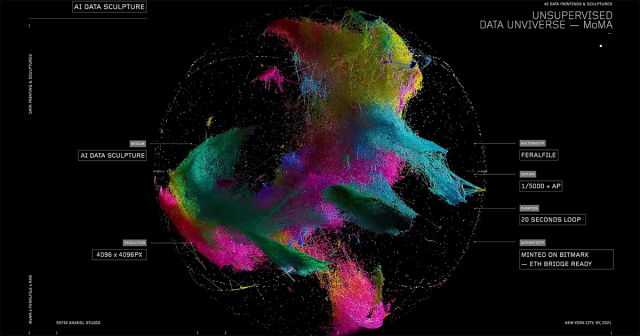READ MORE: Art is Dead. Long Live Art. And DALL-E 2. (Nir Zicherman)
In discussing and assessing a work of art, historically, it seems that the context in which it was created matters. But in an age of AI-generated images, videos, and writing we may need to consider whether that’s the case anymore.
“How can context exist if the art is being created by artificial intelligences with no awareness of society, norms, politics, trends, movements,” poses Nir Zicherman, global head of audiobooks at Spotify and co-founder of podcast platform Anchor.
Zicherman weighs in on the debate about the value of AI-generated art in his Medium post titled “Art is Dead. Long Live Art. And DALLE-2.” Some argue that because machines clearly lack the actual lived experience of a human being (and all art is a reflection and response to being alive), then a work of art produced by AI is clearly not equivalent.
What happens when that context is removed? Or, more exactly, what happens if the context of production is no longer of significance?
Zicherman presents the example of a child’s drawing of a blue rectangle that is likely at some point to be discarded no matter how sentimental the parents might be, in contrast to this 1962 painting by Yves Klein, “IKB 191,” which is considered a masterpiece of post-war French art.
“One might say that much of the beauty or ugliness we see in any form of art comes from our knowledge of where it came from. Let’s be real though. If DALL-E had painted IKB 191, would anyone even know?”
It’s not just critics or the “art world” that extracts value from the context in which art exists.
Context can be related to all our subjective experiences of consuming the art, Zicherman argues. For instance, reading a coming-of-age novel while coming of age yourself might change your perspective on life, while seeing the TV show everyone loves a year or two too late might drain it of any significance for you.
“On the other hand, context can also arise out of how a work of art was created, as well as the time and place in which it came to be. Would Citizen Kane, created today, matter as a film? Would The Beatles, as an up-and-coming retro rock band in 2022, be considered by anyone ‘the greatest band of all time?’”
These questions matter, he says, because we now live in a world where it is possible for machines to generate virtually the same output a human might create:
“What’s even more incredible is that it is now possible to create output humans would never have created. We can generate an infinite number of Picasso-esque paintings, half a century after the artist’s death.”
“How much will future older generations and younger ones disagree about not only which art is great (as all generations do), but about what greatness in art even means?”
— Nir Zicherman
And this trend will only continue, as more and more of the “art” being created each and every day can now exist devoid of any “context” in the traditional sense of the word.
Zicherman points to how that forces us to ask ourselves a different set of questions: Given that new reality, which art will we value and why? What will differentiate the great works from the bad ones? Will we finally reach a point where art can exist on its own, for art’s sake?
This phenomenon is hardly just relevant to images of course. OpenAI (the research lab behind the text-to-image generator DALL-E) has started working on Jukebox, which promises to do for music what they have done for images.
We are only a few years away from videos being generated in the same descriptive way. Surely feature films and entire television shows will follow suit.
So, given how quickly this space is moving, it begs the question of what if children growing up now and falling in love with music, books, and movies during their formative years ascribe entirely different meaning to their art? Would it matter to them if the art that speaks to them was generated by a machine (fed perhaps on the greatest artworks created by humankind)?
Perhaps it matters to us, the older generation more so, because it’s scary and unfathomable that art — which again is how society learns about itself and grows culturally richer — could somehow be outside of our control and generated by banks of servers.
Zicherman considers: “How much will future older generations and younger ones disagree about not only which art is great (as all generations do), but about what greatness in art even means?”
The Filmmaker Bot’s Funeral
By Abby Spessard
“Jan Bot,” the first robot filmmaker in the Eye Filmmuseum in Amsterdam, has been unplugged. Creators Pablo Núñez Palma and Bram Loogman take a walk down memory lane through Jan Bot’s creation with Hyperallergic’s Ben Nicholson.
Jan Bot is an AI that produces experimental short films using the archived material in the Eye Filmmuseum. “Conceived as a way to bring a physical archive into the internet age, the next phase will be posthumously archiving Jan Bot’s oeuvre via NFT,” Nicholson says.

So where did this robot filmmaker creation come from? “I was sharing a studio space with Bram,” Palma starts. “We were recently graduated from a master’s program at the Film Academy in Amsterdam. We had a workshop with found footage filmmaker Jay Rosenblatt. It involved some experimenting with a film collection from Eye called Bits & Pieces.” This collection of clips was started by Eric de Kuyper and Peter Delpeut in the 1990s. “The primary rule for inclusion was that each clip must, in some way, have caught the attention of the curators,” Nicholson explains.
Inspired by the collection, Palma and Loogman wanted to create something relevant and modern with current online spaces. “Bram is a developer, so then we thought, maybe we can make something that creates content — no matter what kind — and is concerned with quantity, not quality. Hopefully this might solve a problem for the Filmmuseum and give us a nice way to experiment.”
Coded with Einstein’s concept of “metric montage,” where film clips are sequenced based on their musical meter, Palma reflects on the examples they used for Jan Bot. “Eisenstein is one of the few filmmakers who talk about syntactic editing… all about the rhythm. He talks about how, by having a certain form of edits — like ‘metric’ — you can start creating momentum by increasing speed and making shorter and shorter shots. Basically, that’s all we could do, because we didn’t know what the shots would be or how they would go together.”
But even with the recurring set of filmmaking practices and parameters, Jan Bot never became repetitive or lost any of its AI interfaces. “If you see it from the perspective of an author, I would say Jan Bot follows the same tradition, because it does the same thing all the time, but the world changes,” Palma says. Jan Bot, until the day of the funeral, remained alive and continued creating new films.
But all good things must come to an end (or so we believe). Those attending the funeral for Jan Bot will be leaving with a card linking to an NFT of one of its films, keeping the robot’s work alive. “If you think of a blockchain as a new way of archiving things on the internet and digital platforms, there was a connection between these films, that bring old archives to the present, and archiving these new movies, made of old footage, in a new form of archive… forever in the blockchain.”


